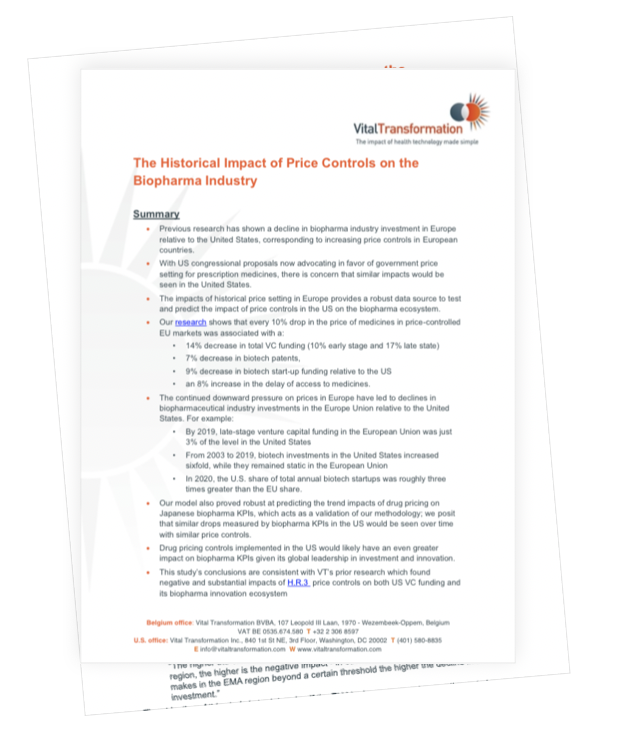The Historical Impact of Price Controls on the Biopharma Industry
Summary
- Previous research has shown a decline in biopharma industry investment in Europe relative to the United States, corresponding to increasing price controls in European countries.
- With US congressional proposals now advocating in favor of government price setting for prescription medicines, there is concern that similar impacts would be seen in the United States.
- The impacts of historical price setting in Europe provides a robust data source to test and predict the impact of price controls in the US on the biopharma ecosystem.
- Our research shows that every 10% drop in the price of medicines in price-controlled EU markets was associated with a:
-
- 14% decrease in total VC funding (10% early stage and 17% late stage)
- 7% decrease in biotech patents,
- 9% decrease in biotech start-up funding relative to the US
- an 8% increase in the delay of access to medicines.
- The continued downward pressure on prices in Europe have led to declines in biopharmaceutical industry investments in the Europe Union relative to the United States. For example:
-
- By 2019, late-stage venture capital funding in the European Union was just 3% of the level in the United States
- From 2003 to 2019, biotech investments in the United States increased sixfold, while they remained static in the European Union
- In 2020, the U.S. share of total annual biotech startups was roughly three times greater than the EU share.
- Our model also proved robust at predicting the trend impacts of drug pricing on Japanese biopharma KPIs, which acts as a validation of our methodology; we posit that similar drops measured by biopharma KPIs in the US would be seen over time with similar price controls.
- Drug pricing controls implemented in the US would likely have an even greater impact on biopharma KPIs given its global leadership in investment and innovation.
- This study’s conclusions are consistent with VT’s prior research which found negative and substantial impacts of H.R.3 price controls on both US VC funding and its biopharma innovation ecosystem.
Background
Previous research has shown measurable declines in the EU biopharma ecosystem relative to the United States, as government price controls on medicines expanded in Europe.
- In 2009, Arthur Daemmrich of the Harvard Business School noted, “Between 1961 and 1980, firms based on the European continent invented and brought to market over sixty percent of new therapeutic molecules. . .By. . .1991, . . .firms in the United States were inventing over forty percent of new drugs . . . Germany’s relative ranking slipped further after 2001.”
- Stephan Eger and Jörg Mahlich, in the Health Economics Review in 2014, found that, “The higher the share of sales made in the [European Medicines Agency] EMA region, the higher is the negative impact – in other words the more sales a company makes in the EMA region beyond a certain threshold the higher the decline in R&D investment.”
The objective of this study is to determine if the EU biopharma ecosystem continues to be negatively impacted by price controls on medicines, and to quantify any statistically measurable impacts that could be extrapolated to the US biopharma ecosystem as U.S. policymakers consider drug pricing reform.
Research Methodology
- A basket of the top 10 selling drugs in the US were selected for each year from 2003 – 2020 to determine their average cost and average access delay relative to the US in Belgium, France, Germany, Ireland, Italy, Spain, Sweden, and the United Kingdom.
- Using data from both public and private sources[i], a multivariate analysis was conducted to estimate the impact of Europe-US price differences with respect to the following:
- Evidence of causality between the use of biopharma price controls on core key performance indicators (KPIs) regarding the European R&D biotech ecosystem.
- The impact of EU-US price differences, driven by price controls in European countries, on delays in access to needed new medicines.
- We then tested our model’s ability to accurately predict the impact of Japanese pharmaceutical pricing on our different biopharma KPIs.
In all cases, an elasticity value measuring the impact of price-controls for medicines in European markets upon our various biopharma KPIs were calculated.
[i] OECD; US Department of Commerce; BioCentury; Medtrack/Informa; Pricentric; IQVIA MIDAS (data combine country-level data, healthcare expertise and therapeutic knowledge in 90+ countries to deliver data in globally standardized forms to facilitate multi-country analyses, a leading source of insight into international market dynamics relating to the distribution and use of medicines. IQVIA MIDAS data is designed to support multi-country analyses of trends, patterns, and similar types of analyses. All of the calculations, algorithms and methodologies used to produce these estimates of real-world activity makes the data highly reliable for these intended uses.); and Social Survey Research Information Company, Ltd (Japan only).
This project was made possible with the financial support of the Pharmaceutical Research and Manufacturers of America (PhRMA), the Biotechnology Innovation Organization (BIO), Amgen, Pfizer, Alexion, AbbVie, Genentech, and Bristol Myers Squibb.
*Datasets used in this research include:
- OECD
- US Department of Commerce
- BioCentury
- Medtrack/Informa
- Pricentric
- IQVIA MIDAS – data combine country-level data, healthcare expertise and therapeutic knowledge in 90+ countries to deliver data in globally standardized forms to facilitate multi-country analyses, a leading source of insight into international market dynamics relating to the distribution and use of medicines. IQVIA MIDAS data is designed to support multi-country analyses of trends, patterns, and similar types of analyses. All of the calculations, algorithms and methodologies used to produce these estimates of real-world activity makes the data highly reliable for these intended uses.
- Social Survey Research Information Company, Ltd (Japan only)




